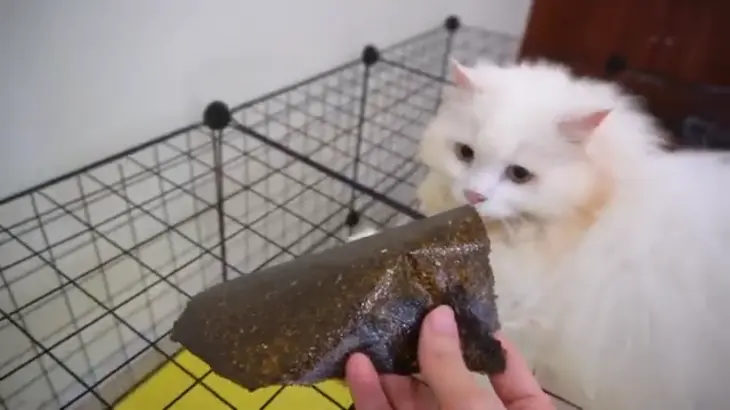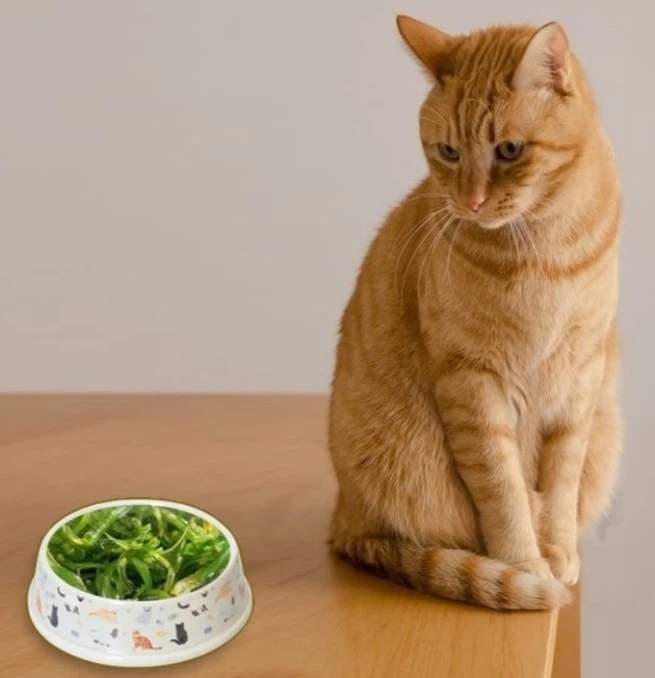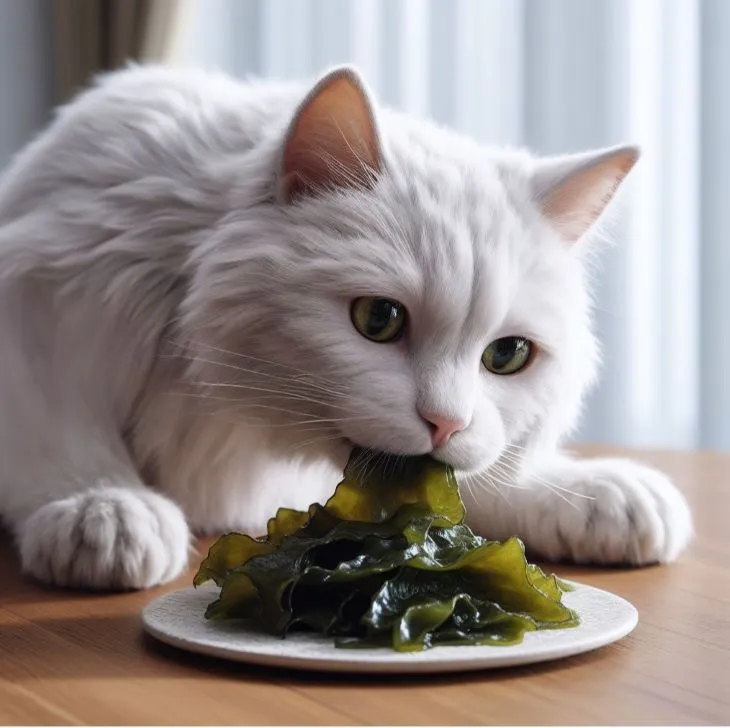Can Cats Eat Seaweed? Exploring The Benefits Of Seaweed On Cats Health
By: Lana Koh

The information in this article is intended to educate cat parents and is not a substitute for veterinary guidance. In case of any concerns about your cat’s health, please talk with your veterinarian.
To ensure the well-being and good health of their feline friends, all cat owners are constantly on the lookout to provide the best nutritional and balanced diet having right combination of essential nutrients, fats and proteins.
Are you also exploring adding new treats to your cat’s diet and wondering Can Cats Eat Seaweed? Do not worry; YES, Cats Can Eat Seaweed in moderation as seaweed provide beneficial vitamins, minerals, antioxidants, and fatty acids that can contribute to cats’ overall nutrition and wellness.
Do you wish to learn more about the related benefits and risks of feeding seaweed to your cat? As someone who is in the well-being of cats and a cat parent for more than a decade, I’m happy to share my experience and describe all the relevant information and pros n cons related to seaweed in a cats’ diet.
Let’s discuss it in detail:
Understanding Your Cat’s Dietary Needs
Cats are true carnivores by nature, which means they need to eat meat in order to obtain certain required nutrients. Cats cannot produce some essential amino acids and nutrients independently, so they must get these from animal-based proteins.
Some plant materials can be healthy for cats, but only in moderation. Too much fiber and carbohydrates from plants can upset a cat’s digestive system. Vegetables, fruits, and seaweed should never exceed 10-15% of your cat’s daily calories. When considering adding new food, even seaweed, to your cat’s diet, check with your veterinarian first about appropriate types and serving sizes.
Click here to read about one of the oldest cat breeds
What Type Of Cats Should Eat Seaweed?
Seaweed can be incorporated into diets for cats of all ages, including kittens, adults, and seniors. However, some types of seaweed and supplements may be more beneficial for cats with certain health conditions.

For example, Kelp powders and supplements containing seaweed extracts are sometimes recommended for cats with hypothyroidism to help support healthy thyroid function.
Expectant mother cats may also benefit from seaweed’s nutritional content. As always, check with your vet before significantly changing your cat’s diet, especially if your cat has any underlying medical issues.
Click here to read: Can cats eat tortillas?
Types Of Seaweed Safe For Cats
Seaweed might sound like an odd snack for cats, but certain types offer great nutrition when given properly and sparingly.
Two popular varieties that are safe and healthy for cats are Kelp and Nori. While others also have some benefits.
Kelp
This nutrient-dense seaweed is generally safe for cats to eat in moderation. It provides vitamins, minerals, and antioxidants. The high iodine content may especially benefit cats with thyroid issues.
Nori
These dried edible seaweed sheets used to roll sushi are non-toxic for cats. Nori contains healthy fats, carbs, and protein. Too much can cause digestive upset.
Wakame
This seaweed is used in miso soup and salads. It is nutritious, bioavailable, and not known to cause harm to cats in smaller amounts. It may help with skin, coat, and heart health.
Seaweed To Avoid
Seaweed can be a healthy supplement for cats in moderation. However, not all varieties are safe. It’s important to avoid flavored, seasoned, and salted seaweed products. Only plain, unprocessed sea greens should be shared with cats.
Steering Clear Of Flavored Seaweed
Many seaweed snacks, like teriyaki, wasabi, or sesame oil, add extra flavor. Spiced-up seaweed strips make tempting human treats. So be sure to read labels carefully on any store-bought seaweed snacks. Choose plain, nutrient-dense sea greens for cat treats without extra spices, salt, or sugar. Sticking to basics like unsalted nori sheets or kelp granules is safest.
Avoiding Processed Seaweed Products
Popular processed seaweed foods like chips, crackers, wraps, or roasted seaweed pack extra calories and sodium which cats don’t need. High amounts of salt and oil lend crunch and intensity to tempt human taste buds. But a cat’s digestive system isn’t designed to handle oily, salty foods well.
10 Potential Benefits Of Seaweed In Cat Food: Why Is Seaweed Good For Cats
Seaweed can be a healthy supplement for kitties in small doses. Dried sea greens contain beneficial nutrients and compounds that support cats’ well-being.

Here’s an overview of some of the top ways sea vegetables may boost cats’ health:
Let’s discuss some prominent benefits in detail:
1. Rich In Omega-3 Fatty Acids
The long-chain Omega-3 fatty acids eicosapentaenoic (EPA) and docosahexaenoic (DHA) found abundantly in seaweed, support skin and coat health, joint mobility, immune system function, heart health, and brain development in cats. These healthy fats also keep skin supple and fur lustrous. Adding just a sprinkle of Nori, Wakame, or Kelp to meals gives cats Omega-3s they likely don’t get enough of from meat-based diets alone.
2. Great Source Of Iodine
The high iodine content in sea vegetables like Kelp can help prevent hypothyroidism in felines. Iodine supports healthy thyroid hormone production, which regulates metabolism. The best way to incorporate supplemental iodine is through Kelp powder or granules. A tiny pinch mixed into wet or dry cat food a couple of times a week supplies adequate iodine for thyroid health without the risks of excess.
3. Antioxidant Properties
Seaweed contain disease-fighting antioxidants that benefit cats. Antioxidant compounds protect delicate cells and tissues from damage by destabilizing free radicals. Exposure to pollution, chemicals, and sun/radiation spawn these volatile molecules within bodies.
4. Digestible Source Of Fiber & Protein
In addition to vitamins and fatty acids, sea vegetables offer cats valuable fiber and protein. Unlike the roughage in land plants, seaweed fiber softens into a gentle bulk that stimulates healthy digestion. A small rehydrated sprinkle of wakame, kelp, or Irish moss helps food smoothly move through the gastrointestinal tract.
This soluble fiber relieves constipation by binding to toxins and waste for elimination. It also feeds beneficial probiotic gut flora. Marine greens also contain highly digestible complete proteins themselves. Dried chlorella and other algae supply 18 amino acids, forming the building blocks cats need for cell repair and tissue growth.
5. Nutritional Value
Seaweed is a soothing internal antacid despite having no overt stomach issues.
Regular tiny doses ease digestion and reduce acid reflux cats occasionally suffer from. Anthelmintic properties may also gently flush intestinal parasites. The amino acids in Kelp and Nori help deter external parasites too for a lustrous, flea-free coat and more.
6. Rich In Vitamins And Minerals
In addition to unique protective compounds, sea vegetables contain essential vitamins and minerals critical to feline health. A sprinkle of dried Wakame or sea lettuce delivers a dose of vitamins A, C, E, and B12. These support healthy vision, nutrient absorption, blood oxygenation, and nerve conduction in cats.
Kelp, Dulse, and Nori also provide potassium for muscles and heart, calcium and phosphorus for bone strength, iron for oxygen-carrying red blood cells, and zinc for DNA synthesis. Incorporating seaweed multidimensionally safeguards cats against deficiencies for resilient wellness from nose to tail.
7. Supports Thyroid Function
The thyroid gland oversees metabolism for converting nutrients into cellular energy. Iodine enables adequate thyroid hormone synthesis to perpetually stoke internal fires. Cats require sufficient iodine intake to optimize bodily processes like heart rate, digestion, and body temperature.
Dulse, Kelp, and Kombu brim with bioavailable iodine to precisely nourish the thyroid, paired with antioxidants that protect delicate endocrine tissues. A small sprinkle supplies the ideal catalyst, keeping cats vigorously fueled through every life stage.
8. Improved Coat Sheen
Many commercial cat foods contain excessive fats that gradually cause weight gain. Seaweed provide the ideal balance of Omegas, Vitamins, and Minerals for flawless coats minus the fat.
9. Reduce Free Radical Damage
A cat’s aerobic life produces unstable free radical molecules that inflict oxidative damage on cell components like DNA, enzymes, and cell membranes. This stress deteriorates health and accelerates aging over time. Fortunately, antioxidants neutralize problematic free radicals before catastrophe. Sea greens combine potent antioxidants like carotenoids, vitamins C and E, and beneficial minerals.
10. Vitamins A, E And B12
Seaweed contains many crucial vitamins cats frequently lack from meat-based diets – such as Vitamin A, E, and B12. Vitamin A supports healthy vision and skin tissue growth. Vitamin E protects cells from free radical damage. And B12 maintains nerves plus nutrient metabolism. Sprinkling just a pinch of mineral-rich kelp or dulse supplies these vital micronutrients for full-bodied wellness.
Risks/Dangers Of Feeding Seaweed To Your Cat
While seaweed does offer many health benefits, it also comes with some risks for cats. Be aware of the potential dangers, from digestive issues to toxicity, before serving your cat even small tastes of sea greens.
Why chocolate is dangerous for cats? Click to read
High Sodium Content
While plain dried sea greens contain naturally low sodium, many popular seasoned seaweed snacks do not. High salt compounds quickly overwhelm cats’ limited kidney function. Early symptoms of sodium toxicity include thirst, vomiting, and diarrhea. But left unchecked, salt poisoning causes severe neurological impairment from cellular dehydration. Always verify sea vegetables have no added salt before sharing.
Risk Of Heavy Metals
As marine filter feeders, seaweeds bioaccumulate toxins from ocean pollution that concentrate on food chains. This includes heavy metals like mercury, cadmium, lead, and arsenic. Excessive buildup of such neurotoxic contaminants over time can irreversibly poison cats. Always source reputable sea vegetables sold specifically for cats or human consumption with independent lab-verified purity standards.
Expansion In Stomach
Dried seaweed can expand a lot when cats eat it. Cats are built to only eat small amounts of plants. Too much extra fiber and swelling can block their sensitive digestive systems. Large pieces also increase this risk.
Before feeding dried seaweed, soak it in water so it expands on its own. Then limit nibbles to tiny portions that won’t overwhelm your cat’s tummy in one sitting. Small tastes spaced apart let the kitty safely explore these new ocean snacks.
Serving Size And Frequency
The following chart offers general feeding guidelines surrounding safe, nutritional seaweed serving sizes for cats by weight. However, check with your veterinarian first, especially if your cat has any pre-existing health issues:
| Cat Weight | Max Dried Seaweed Per Day | Max Rehydrated Seaweed Per Day | Frequency |
| 2 – 6 lbs | 0.5 teaspoon | 1 tablespoon | Up to 2 times weekly |
| 7 – 10 lbs | 1 teaspoon | 2 tablespoons | Up to 2 times weekly |
Comparison To Natural Diet
Cats are hyper-carnivores, meaning they must eat meat to thrive. The table below compares some of the key nutrients felines require to the nutritional content seaweed offers:
| Nutrient | Found in Prey | Found in Seaweed |
| Protein | High | Moderate |
| Fats/Omegas | High | Low-Moderate |
| Vitamin A | High | Low-Moderate |
| Taurine | High | None |
| Iodine | Low | High |
So while sea greens provide some beneficial vitamins, minerals and antioxidants, they lack the complete amino acid proteins with essential fatty acids that cats need from whole food animal sources.
Seaweed As A Snack
In moderation, dried seaweed can provide a crunchy, appealing, low-calorie treat for cats. Just a small strip of nori or square of dried kelp now and then provides the healthful nutrition cats crave with a satisfying texture.
However, cats may potentially gorge on rehydrated sea greens. So, it is best to share only dried sea vegetables as a supplemental treat. Shred or cut dried seaweed into pieces smaller than your cat’s paw for safety.
Also, always supervise your cat when first trying seaweed to watch for signs of choking or overindulgence leading to vomiting. Discontinue use if your cat shows signs of digestive upset or lack of interest.
Alternatives To Feeding Your Cat Seaweed As A Snack
Though seaweed can make an occasional nutritious cat snack, variety is key for a balanced feline diet. Consider rotating in other safe, low-calorie nibbles in place of or in addition to dried sea greens. Always check with your veterinarian, but here are some healthy swap-in options to mix up treat time:
Cooked Fish
Flaky cooked fish can make a healthy treat for cats. Popular types like salmon and tuna have good fats called omega-3s for cats’ skin and fur. Be sure to cook plain fish fillets without any salt or oil added. Check the fish carefully for tiny soft bones that could choke a cat.
Commercial Cat Treats
Veterinarians say to switch up snacks so cats don’t get bored or fixated on one food. Many commercial cat treats are made just for cats and come in yummy flavors like chicken, salmon, or catnip. Some soft freeze-dried treats are chewy, which encourages chewing. Hard kibble-style treats help scrub cats’ teeth clean. Some special treats have ingredients like glucosamine for joint health or probiotics to help their digestion. Look for minimally processed treats low in carbs and fat that your vet recommends based on your cat’s needs.
Cooked Eggs
Fluffy, simple scrambled egg whites or whole eggs make an easily digestible, nutrition-dense snack cats love. Gently cooking leaches out proteins and amino acids better than raw. But never add milk, salt, onion, or other unnecessary human favorites. Two or three tiny cooled spoonful’s once a week prevent stomach upset and potential skin reactions.
Cooked Meats
Shredded bits of plain boiled chicken or turkey make crazy-delicious kitty candy. Low-fat mixes offer pure protein minus dangerous bones or herbs. Always cook until well done without added oil or salt. Cats” bodies struggle to digest.
How To Serve Seaweed To Your Cat
Seaweed shouldn’t become a staple feline food. As carnivores need meat-based proteins, cats lack adaptation to fully break down many plant fibers and minerals.

When sharing seaweed, select simple dried varieties containing just the sea vegetable. Avoid added oils, spices, or salt compounds that are unhealthy for cats.
Feed tiny pinches of the dried leaves one to two times weekly at most, either in plain pieces, flakes, or granules.
Alternatively, for easier mixing, briefly soak dried seaweed in purified water until it expands, then drain it.
How Do You Know If Your Cat Has Over-Eaten Seaweed?
Cats unaccustomed to seaweed may overindulge if allowed free access. Watch for these symptoms of gastric distress or toxicity signaling too many salty sea greens:
- Repeated vomiting or diarrhea
- Lack of energy, moving less
- Hunched posture showing abdomen discomfort
- Drooling, panting, or gasping from excess iodine
Discontinue seaweed immediately if any concerning issues develop post-snacking. Moderating treats prevents dire consequences of overeager consumption.
Frequently Asked Questions
Conclusion
When fed occasionally in tiny portions, most healthy cats can enjoy dried sea greens like Nori or Kelp as an appealing snack. As with any human foods offered as supplemental pet treats, practice moderation. Check with your veterinarian about appropriate sea vegetables and serving sizes for your cat’s needs. Monitor your cat’s reaction after first trying seaweed and discontinue use if any concerning symptoms develop. With abundant caution and common sense, seaweed can enrich cat nutrition!
